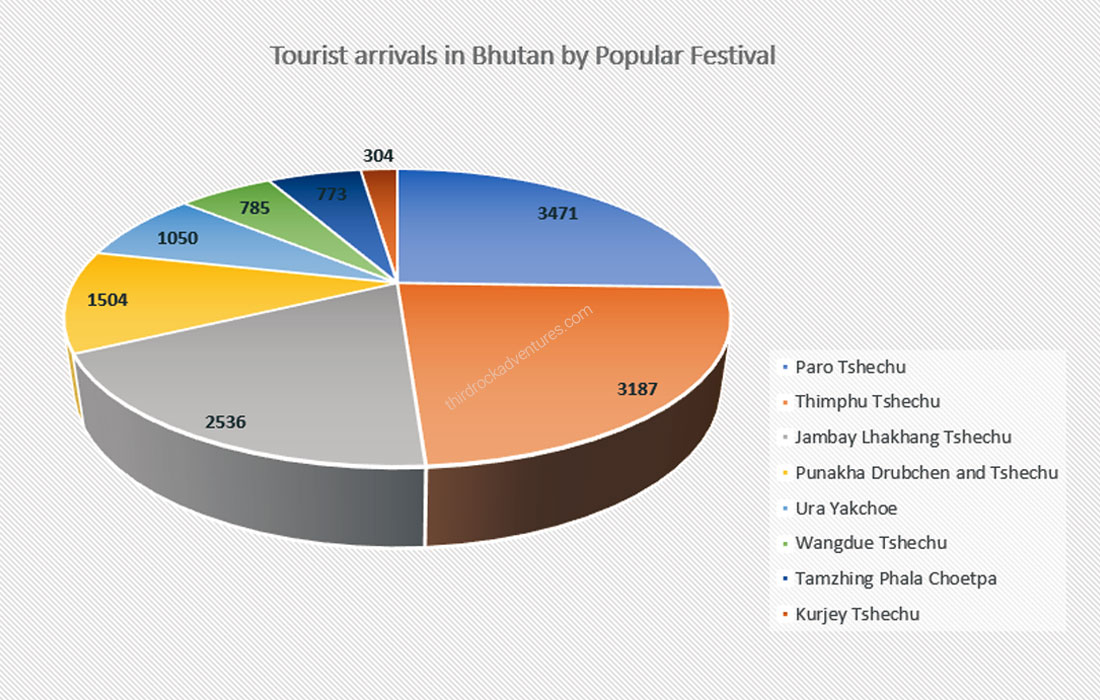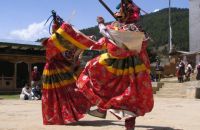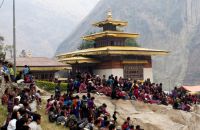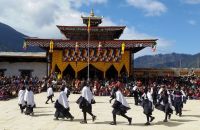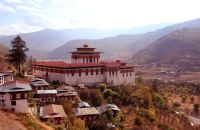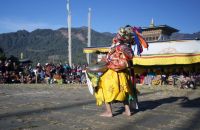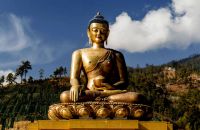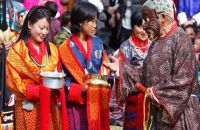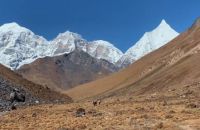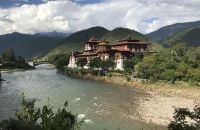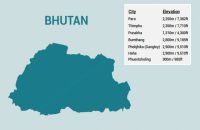Talk with our local travel specialist who can help organize your trip.
Discover the Top 25 Festivals in Bhutan: A Cultural Extravaganza!
Festivals in Bhutan are vibrant and colorful celebrations.These are often held at the monasteries and lakhangs (Buddhist temples), and presided over by the monastic community. People from all walks of life converge at the monasteries to observe these sacred occasions. During these festivals the monks deliver religious sermons, perform masked dances and skits..Embarking on a festival tour and attending these vibrant celebrations is a wonderful way to gain a deeper understanding of the local cultures and traditions in Bhutan. By immersing yourself in the festivities and interacting with the locals, you will have the opportunity to learn about their way of life, history, and values.. As one of the last surviving Buddhist kingdoms in the Himalayas, Buddhism in Bhutan is not just a religion; it is a way of life.
Tshechus are Buddhist religious festivals held annually at the major districts or Dzongkhags in Bhutan. Tshechu, which means 'ten' are held on the tenth day of a month on the Bhutanese lunar calendar. The tshechus are performed in honor of Guru Rinpoche or Padmasambhava who introduced Buddhism in Bhutan.
These vibrant festivals involving masked dances, folk songs and skits are held in dzongs or the courtyard of important monasteries of the dzongkhangs. These celebrations provide an opportunity for the commoners to mingle with the monastic community. It is believed that attending a tshechu and watching the monks' performances will wash away your sins and multiply your blessings.
25 Best Bhutan Festivals:
If you are planning on taking a journey to land with natural and cultural beauty, then Bhutan is the place for you. Bhutan festivals are called Tshechu which is the religious event where monks perform dances in colorful attires and masks to seek blessings from the gods and subdue the evil spirits.
We have listed down 25 best festivals of Bhutan where you get to be a part of the biggest celebration and create memories of the lifetime.
Table of Content
- Jambay Lakhang Festival
- Dochula Druk Wangyel Festival
- Haa Summer Festival
- Punakha Drubchen
- Black-Necked Crane Festival
- Paro Tshechu
- Thimphu Tshechu
- Punakha Tshechu
- Wangduephodrang Tshechu
- Kurjey Tshechu
- Ura Yakchoe
- Gomphu Kora Festival
- Nimalung Festival
- Chorten Kora Festival
- Jomolhari Mountain Festival
- Lhuntse Tshechu
- Matsutake Mushroom Festival
- Merak Tshechu
- Mongar Tshechu
- Nomad Festival
- Pema Gatshel Tshechu
- Sakteng Festival
- Trashigang Tshechu
- Gasa Tshechu
- Trongsa Tshechu
1. Jambay Lakhang Festival
Jambay Lhakhang Festival is held on the grounds of Jambay Lakhang temple in Bumthang. One of the ancient temples in Bhutan, Jambay Lakhang was built in the 7th century by Songsten Gampo, the Tibetan emperor during the 7th century AD. The temple is one of the 108 lakhangs built to subdue the demons that were troubling the people residing in the Himalayas. It is believed that Jambay Lakhang and Kichu Lakhang in Paro were built on the same day by Songsten Gampo. Guru Padmasambhava himself visited the temple several times and deemed it very sacred.
The spectacular festival of Jambay Lhakhang is held at this temple every year in November. The festival lasts for five days and people from far and near gather at the temple to celebrate. Monks perform cham or masked dances. The highlights of this festival are Merwang and Tercham. Merwang is a fire ceremony where the participants run underneath a flaming arch made of dry grass. Tercham or the ‘Dance of Treasure’ is performed late at night by naked dancers wearing masks. It is believed that performing Tercham brings blessings to infertile women. The fire dances attract many locals as well as tourists. Take the Jambay Lhakhang Festival Tour to take the experience of this wonderful festival.
2. Dochula Druk Wangyel Festival
This festival is held at the Druk Wangyel Lhakhang festival ground located at Dochula Pass. Dochula Druk Wangyel Festival was first observed in 2011 in memory of the Fourth Druk Gyalpo (King Jigme Singye Wangchuk) and the Bhutanese armed forces who were involved in a battle with insurgents in 2003. The construction of Druk Wangyal Lhakhang was ordered by Her Majesty the Queen Mother Ashi Dorji Wangmo. It was built over a period of four years (2004-2008) under her majesty's supervision.
This one-day festival is held annually in December. Spirited chams or masked dances are performed. The Je Khenpo (chief abbot) together with other lamas(monks) perform religious folk dances and songs. The chief highlight of the Dochula Druk Wangyel Festival is the magnificent outdoor setting. Held in Dochu La Pass, it is a treat to watch the colorfully attired monks perform under the backdrop of panoramic mountain views. The Dochu La Pass lies around 22 km from Thimphu. This place is one of the most scenic locations in the country. It offers stunning views of the Himalayas. The festival set against such beauty is an experience like none other.
3. Haa Summer Festival
Haa Summer Festival is an outdoor festival that celebrates the spirit of Bhutan's nomadic herders. This is a 2-day celebration held in Haa Valley in July. The festival showcases the rich culture and nomadic traditions of the Haa inhabitants. Major highlights include Ap Chundu dance by female dancers, masked dances, archery, and flat stone swing competitions, etc. Various stalls are erected where visitors can watch tableaus, exhibitions, or buy local handicraft items.
Haa Valley is located very close to Paro international airport. To get here, you will have to cross Bhutan's highest road pass which is very exciting. You will get to enjoy one of the most pristine trails and of course Bhutan's flora and fauna. People gather around on open fields sampling delicious homemade food, playing traditional sports. Homemade liquor is sipped while people play traditional songs and dance to their tune. At the Haa Summer festival, you will also get to see fields of white poppy; a variety of poppy that is not found anywhere else in the world.
4. Punakha Drubchen
Punakha Drubchen is one of the grandest annual festivals celebrated in Bhutan. In the country's former capital, Punakha western Bhutan, the festival falls on February or March and is celebrated for 5 days. The Punakha Drubchen or Dromche commemorates the gallantry and victory of the Bhutanese while fighting the invading Tibetan forces during the 17th century. The Bhutanese forces were led by Zhabdrung Ngawang Namgyal, popularly known as the Bearded Lama. After the war with the Tibetans, Zhabdrung Ngawang Namgyal unified Bhutan.
The Tibetans had waged a war against the Bhutanese to seize Ranjung Kharsapani, a precious self-made image of Avalokiteshwara or Chenrizing (the God of Compassion). Zhabdrung Ngawang Namgyal of Punakha cleverly duped the Tibetans by pretending to throw the precious relic into the Mochu River. The Tibetan armies had retreated when they saw the Zhabdrung throw the fake relic into the river.
During the festival battle scenes from the historic 17th-century battle are reenacted. Young men from eight Bhutanese Gewogs or clans - Chang, Mewang and Kawang from Thimphu and Shengana, Baap, Tewang, Toeb and Khabjisa from Punakha- are selected as Pazaps (local warriors who fought under Zhabdrung Namgyal,Zimpons (Generals) and Gups (Zabdrung's representatives). The Pazaps and Zimpons dress up in magnificent battle gear, ride horses and reenact the battle scenes, while Gups dress up as Lamas and guide the warriors.
The most important ceremonies are the Bae and the Bae Cham. Bae is the groundbreaking ceremony where Pazaps sing war songs and demonstrate how to fight a war. Bae Cham is the war dance performed by the Zimpons in front of the Je Khenpo (Chief Abbot) and the Gups. Both these performances are held at the courtyard of the Punakha Dzong. This will be followed by a religious procession where many Buddhist monks led by Je Khenpo will head to the Mo Chu River and throw some oranges symbolizing the fake relic's immersion. Later Pazaps and Zimpons celebrate their victory at the dzong's courtyard.
You can witness this grand festival by visiting Bhutan during the Spring season. The festival falls on either March or April as per the Bhutanese Lunar calender. You can book any one of these trips to take part in this vibrant festival – Nepal and Bhutan Tour (9 days), Bhutan Cultural Tour (5 Days), Bhutan Heritage Tour (8 Days), and Bhutan Nepal Tibet Tour(14 Days)
5. Black-Necked Crane Festival
The Black-Necked Crane Festival is held in the ancient Gangtey Gompa in the Phobjika Valley every year on November 11. The festival is held to celebrate the arrival of the Black-Necked cranes to Bhutan from the Tibetan plateau. Every year these endangered birds fly all the way from Tibet to roost on the Phobjika valley's wetlands.
For Bhutanese, the black-necked cranes symbolize longevity, and they are believed to bring good luck and prosperity to this Himalayan kingdom. One can image of these elegant birds painted on holy sites and temples. The birds are sacred as the locals regard them as reincarnations of two deities who protect the valley. The cranes circle the valley three times while arriving and departing from the valley. Locals believe that this is a way for the birds to pay homage to Buddhism's three jewels for protecting them.
The Black-Necked Crane Festival was organized for the first time in 1998 by the Phobjika Environment Management Committee and Royal Society of Protection of nature to raise awareness about this endangered birds' role in Bhutanese culture and traditions and to protect them. The festival is observed in the large courtyard of the Gangtey Gompa, one of the oldest Nyingmapa monasteries in Bhutan. Locals, as well as tourists, gather to witness the masked dances, skits and folk songs. The festival offers a rare opportunity for tourists to not only get an insight into local culture but a chance to support conservation efforts to save this magnificent and endangered bird. You can book our Black Necked Crane Festival Tour to take part in this vibrant festival.
Suggested Read: Bhutan Festivals Calendar
6. Paro Tshechu
Paro Tshechu is one of Bhutan's oldest and most important monastic festivals. This Paro festival was first celebrated in 1644 when Zhabdrung Ngawang Namgyal consecrated the Paro Dzong. This 5-day long religious festival held at the Paro or Rinpung Dzong is dedicated to Guru Rinpoche, the Buddhist spiritual master who introduced Buddhism in Bhutan. Paro Tshechu is a major attraction for both locals as well as tourists. It is believed that attending a Tshechu and watching the monks sing and dance will bring you blessings and spiritual merit. People come from far and near to take part in the festivity.
As per the Bhutanese lunar calendar, the Paro Tshechu begins on the tenth day of the second Bhutanese month and ends on the fifteenth day. During the festival, Cham (masked) dances and tantric rituals are performed by monks. The performances depict the saintly deeds of Guru Rimpoche. Monks don elaborate and colorful silk costumes and masks and perform masked dances.
One of the most special dances performed during the festival is the Shingje Yab Yum, the Lord of Death's dance and his consort. Other dances include Shana or the Black Hat Dance, Dramitse Ngacham or the Dance of the Drums from Dramitse, Sha Tsam or the Dance of the Four Stags, Tungnam or the Dance of the Terrifying Deities etc.
On the last day of the festival, a gigantic thangkha or thongdrel (embroidered scroll painting) of Guru Padmasambhava is displayed to the public. The ceremony is held early in the morning, before the sunrises. The giant thangka depicts the eight manifestations of Guru Rinpoche or Padmasambhava. Buddhists believe that witnessing the unfurling of this thangka at the Rinpung Dzong will cleanse you of your sins. The King of Bhutan also makes it a point to attend this religious ritual.
Experience the rich culture of Bhutan by attending the Paro Festival. Book our Paro Festival Tour or any of our Bhutan trips during the festival to fully immerse yourself in this religious celebration.
7. Thimphu Tshechu
Thimphu Tshechu is one of the biggest and the most important festival celebrated in Thimphu, the capital of Bhutan. Tshechus are celebrated in Bhutan's major cities in honour of Guru Rinpoche (Padmasambhava) who brought tantric Buddhism to Bhutan in the 8th century. Thimphu Tsechu was first observed in 1670 AD, during the reign of Tenzing Rabgye, the fourth ruler of Bhutan, to celebrate the birth anniversary of Guru Padmasambhasava. This 3-day long festival is celebrated on the eighth month of the Bhutanese lunar calendar at the magnificent Tashichho Dzong.
Thimphu Tsechu is witnessed by thousands of people who travel to Thimphu from far and near. As it is a religious festival, Bhutanese believe that they are blessed by Bhutanese saints and gain merit by attending a Tshechu. During the festival, masked dances representing the life of Guru Padmasambhava are performed.
When it first started, only a few Chham(masked dances) were performed by the monks. Dance of the 21 Black(Zhang Nga Chham, Dance of the Lord of the Cremation Ground (Durdag) and Terrifying Deities Dance (Tungam) were some of the few dances. The 3rd King of Bhutan, Jigme Dorje Wangchuk, during the 1950s introduced some more dances to the Thimphu Tsechu. The dances that were included are known as Boed Chams and lay monks perform these. The new chhams added more variety and color to this vibrant festival.
The other major performances that one can enjoy are the Shaw Sachi (Dance of the Stags) and Guru Tshengye (8 Manifestations of the Guru). Viewing these performances is considered to be very spiritual and believed to cleanse one's sins. Locals from other Dzongkhags(areas) converge to the capital city of Thimphu to take part in this religious festival.
Witness this vibrant festival and celebrate with the local Bhutanese wonderful festival by booking our Bhutan Heritage Tour and Bhutan Cultural Tour.
8. Punakha Tshechu
Punakha Tshechu is held right after Punakha Dubchen, the most magnificent festival in Bhutan showcasing the ancient Bhutanese army's military prowess. Punakha Tshechu is celebrated in late February or March at the grounds of the Punakha Dzong. The festival was first held in 2005 after a request was put forward to the 70th Je Khenpo (Chief Abbot) and administrative body by the locals for a celebration honoring the teachings of Padmasambhava.
The tshechu, which lasts for 3 days, is held to honor Guru Rinpoche or Padmasambhava and to celebrate his good deeds. The monks perform colorful cham dances and religious skits. Local people dressed in their finery attend this sacred festival and seek blessings from the Buddhist monks. This colorful ends with the unfurling of a huge thongdrel (giant thangka or scroll painting) of Guru Rinpoche. It is believed that one receives the blessings of the guru directly by setting eyes on the image of the guru on the thongdrel.
9. Wangduephodrang Tshechu
Celebrated in September, Wangduephodrang Tshechu is one of the oldest annual tshechus celebrated in the Himalayan country. This annual festival is held in the Wangdue Phodrang district of central Bhutan. Zhabdrang Ngawang Namgyal first introduced the festival in the 17th century after the completion of the magnificent Wanduephodrang dzong.
The 3-day festival is held on the grounds of this dzong and sees the participation of locals living far and near. This is the biggest cultural festival held in the district or dzongkhang and people living as far as Thimphu and Punakha flock to the dzong to be a part of this tshechu.
One of the major highlights of this festival is the Raksha Mangcham or the dance of the Ox. The monks living in the monastery perform energetic Cham dances, songs and Buddhist skits. The festival concludes with the unfurling of the huge thongdrel with the image of Guru Tshengye. All the locals attend this ceremony as witnessing the unfurling of the sacred thongdrel is believed to wash away your sins and accumulate your blessings.
10. Kurjey Tshechu
Kurjey Tshechu is held in January in Kurjey Lakhang (temple) of Chokhor Valley in Bumthang district. The festival is held in honor of Guru Rinpoche who is believed to have saved the inhabitants of the valley by subduing the demons and evil spirits.
According to Bhutan's local legend, Sindhu Raja was concerned with the suffering brought about by the evil spirits that he invited Padmasambhava or guru Rinpoche (the Second Buddha) from Nepal to destroy the evil forces. Guru Rinpoche arrived and chose a cave that looked like thunderbolts or dorjes to meditate. He was successful in removing the evil spirits after a long meditation. His meditation was so intense that he left an imprint of his body on the wall of the cave. Thus the locals named the place Kurjey, meaning ‘imprint of the body.’ Three temples were built on this sacred site. The first temple was built in 1652 by the first Governor of Trongsa, while other two temples were built in 1900.
Kurjey Tshechu or festival is observed to celebrate the victory of Padmasambhava over the evil spirits. Locals from Jakar and Kurjey congregate at the lakhang to pay respects to the guru and seek blessings from the lamas(monks). The monks of Kurjey Lakhang perform cham dances and skits during the festival. This grand festival ends with the unfurling of the magnificent thongdrel or a giant thangkha (scroll painting) of Lord Buddha.
11. Ura Yakchoe
Ura Yakchoe is a famous dance performance in the Ura Valley of Bumthang. In this festival the sacred dance, folk dances are performed with a sacred relic on display to receive the blessings from the same. According to mythology, a lama visited one local woman in her house suddenly and asked for a glass of water.
After coming back, she went to fetch water and found the lama nowhere to be found leaving the sacred relic behind. It is this artifact before which the Ura Yakchoe dance is performed. This relic has been passed on for decades of the woman's family.
This is one of Bhutan's devout and religious festivals where many devotees visit to worship the relic. The festival holds historical significance and is held at the Ura Lhakhang in Bumthang. By witnessing sacred dance performances, people learn about the faith of the Bhutanese people and their culture. The three-day festival creates zeal and enthusiasm which is a unique experience to treasure for a lifetime.
Recommended Trip: Ura Yakchoe Festival Tour
12. Gomphu Kora Festival
Gomphu Kora Festival (also called Gomkora Tshechu) is a famous festival celebrated in eastern Bhutan every spring. The word is divided into three where ‘Gom’ means meditation, ‘Phu’ means cave and ‘Kora’ is circumambulation.
The name is formed from a cave made of a rock-face next to a temple built as a tribute to sacred site. It is celebrated at the Gom Kora Monastery which is 23 kilometers away from Trashigang Dzong.
You can see people from all over eastern Bhutan coming to this narrow valley dressed in their finest attire. The festival is famous to find a soul-mate that leading to marriage. The three-day religious festival attracts Dakpa tribe from neighboring Arunachal Pradesh (India).
The festival dates back to Guru Rinpoche (Padmasambhava) who mediated in the cave for three months when he cowed the demon, Mongkhapa. You can truly witness Bhutan rich cultural and traditional heritage which is pristine and beautiful. Attend this festival and experience Bhutanese culture by booking our Gomkora Tshechu Festival Tour - 13 Days
13. Nimalung Festival
Nimalung Lhakhang is situated in Chumey in Bumthang which is a 15-minute drive from the village of Chumey. The Lhakhang was co-founded by Dasho Gonpo Dorji and Doring Trulku Jamyang Kunzang in 1935. The main relic of the two-storied temple is a superb figurine of Guru Rimpoche. The monastery is adorned with murals of the Nyingmapa and Drukpa traditions. There are paintings of Guru Rimpoche and his disciples, the origin of Terton Pema Lingpa, and numerous Buddhist rulers allied with the monastery.
One of the most important festivals held at the Lhakhang is the Kaling Zhitro Drubchen which is initiated by Doring Trulku and he was the first person to have started the rite in Bhutan. It is held on the first fifteen days of the first month of the Bhutanese calendar. During the Tshechu an awe-inspiring Thongdrol of Guru Rimpoche is put on display which is nine meters long and twelve meters wide. The Thongdrol which was contributed by Lopen Pemala and was sanctified in June 1994 in the attendance of a large crowd of villagers by Lhalung Thuksey Rimpoche, the re-embodiment of the mental aspect of Pema Lingpa. During the festival, a series of flamboyant and remarkable mask dances are performed. You can book our Bumthang Nimalung Tshechu Tour to take part in this festival.
14. Chorten Kora Festival
Chorten Kora is a famous Bhutan festival that offers a look into Bhutan's ancient and rich culture. Celebrated in the eastern part of Bhutan, Trashiyangtse is famous for its cultural importance. Dakpa Kora is held on the 15th day of the third month and Drukpa Kora is held on the 30th day corresponding to the 15th March every year.
Chorten Kora is a stupa created by Lama Ngawang Lodro in 1740. It was dedicated to the memory of his late uncle, Jungshu Pesan. It is considered to be replica of the Boudhanath Stupa in Nepal.
The Chorten was built so that people can visit the temple in Trashiyangtse instead of going to Nepal. It is also believed that the Dakini agreed to be buried alive inside the chorten. For this, the ritual is organized every year to celebrate.
15. Jomolhari Mountain Festival
Enjoyed for two days, Jamolhari Mountain Festival is one of the most attractive sites you will ever get to see. The magnificent landscape and the amazing people are the heart to the festival celebrated at the heels of Mt. Jomolhari. This festival is important for the locals living around this place. The festival is called the snow leopard show which makes people aware of the declining numbers of snow leopards.
During the festival, you will enjoy the locals dressed in colorful traditional attires. People enjoy the traditional folk dance on the folk songs. As a tourist, you will surely enjoy the show and you will never forget the entire experience you have in this festival.
Jomolhari Mountain Festival is a divinely themed two-day event that offers the beauty of Bhutanese culture with the natural wonders that surround them: one, in particular, is the abstract, yet elegant, snow leopard! This endangered animal booms in the region; that is why you can see several camera trap photos along the way.
16. Lhuntse Tshechu
Lhuenste is one of the easternmost districts in Bhutan. As the inherited home of the Kings it hosts a number of sacred monuments. The most important amongst these is Lhuntse Dzong, a royal fortress that sits upon a high point overlooking the Kurichu River. Every village in Lhuntse conducts festivals that are unique and distinct in Bhutan. Two major festivals are the Cha and the Ha festivals.
They are celebrated to honor the divinities and stop bad luck. However, the most important festival is the annual three-day festival. The Tshechu is usually celebrated in the month of November and lures number of people together for religious celebrations.
During the Tshechus people can cleanse their sins as they watch the masked dances and receive blessings from sacred relics. One of the most amazing aspects of these Tshechus is the colorful attire of Kushithara that Lhuentse is famous for. You will come across various patterns of Kira and rich ornaments on display.
The ancient region of Kurtoe or Lhuntse is Bhutan Kings' ancestral home that hosts several sacred sites. The scenery around Lhuntse is remarkable along with the towering view above river gorges and dense forests.
The Tshechu in Lhuntse is celebrated in the month of November, December where people witness dzongkhag's biggest festival and pay their respect to the sacred relics Several mask dances such as Sha Zam Cham, Sachhog Zhana cham, Daegye Bakcham are performed in the festival
17. Matsutake Mushroom Festival
Matsutake festival is enjoyed alongside the people of Ura, Matsutake festival is an opportunity to not only enjoy the meals but also to cultivate a deeper insight into the lifestyle of Bhutanese village.
You can enjoy how to harvest the fabled wild Matsutake mushrooms of Bhutan. The forest of Ura Valley in central Bhutan is the major aspect of the festival. You can enjoy the valley's mesmerizing trail and bring in the thrill of discovering the mushroom, beautiful temples, and monasteries. The people of Ura consist of some 50 clustered family homes that give the distinct feeling of an isolated area.
This festival falls during the 4th weekend of August and takes place in beautiful Ura valley. Ura is celebrated as one of the most attractive valleys with the authentic experiences of traditional rural Bhutanese life. You will learn to recognize these famous mushrooms at the festival as they embark on mushroom picking excursions.
18. Merak Tshechu
The Merak Valley in Tashigang in Bhutan's eastern part is a unique place filled with semi-nomadic groups called Brokpas. Situated at an elevation of 3000 meters, the valley is free from the modern world and makes it thus special. The lives of the locals Brokpas are encountered with nature and people survive by rearing yaks and other animals.
The Merak Tshechu is a festival at Merak Lhakhang, which is held for three days and offers a recreational break to the Brokpas from cattle herding's monotonous life. You can enjoy the people making traditional dances and music is performed. Ache Lhamo, a famous dance, is performed during the festival, which attracts many tourists to this valley. You can see the people wearing the attire of Dakpas which is clothing is woven out of Yak hair and sheep wool.
You can find a unique culture of polyandrous culture which is rarely seen in South Asia nations. Here, the women are allowed to marry more than one husband of the same family. These locals are full of lives and are known for their music and dance amongst the locals.
19. Mongar Tshechu
Mongar Tshechu is the multi-day yearly occasion celebrated each year in November. This is one occasion you will truly enjoy as you will be peeking into Bhutan's way of life and custom. You will have the chance to see individuals from Lhunentse and even Trashigang.
The most fantastic aspect of this occasion is the number of conventional moves. Come and visit the occasion to get the genuine essence of Bhutan inside and out. The new Dzong in Mongar was erected in 1953.
While you are in Bhutan, you should definitely visit Mongar and enjoy the Mongar Tshechu. This three-day annual event is organized every year in November which showcases the beauty of the people and their love and respect for the culture, tradition and values. The event is famous which is why many national and international tourists from all over the world come to see the festival. You can enjoy numerous dances and performances that keep the beauty of Bhutan alive.
20. Nomad Festival
The Nomad's festival is held in Bumthang Dzongkhag (district) in Central Bhutan. Bumthang is 8-hour drive from the capital city of Thimphu. To get to Bumthang you must follow the national highway east, past Wangdue and Trongsa Dzongkhags.
You cross 3 high mountain passes wreathed in cool mists, offering spectacular views of the Himalayan landscape and through stunning, unspoiled forests rich with a wide array of flora and fauna.
Travelers can elect to either spend a night in Trongsa or to travel straight to Bumthang. It is recommended that you leave lots of time for your journey to better allow you to appreciate the beautiful sights. Bhutan's nomadic highlanders' annual gathering brings together the nomads of the northeastern and northwestern Himalayan frontiers in an unforgettable celebration of their unique culture and traditions.
Dress like a Bhutanese and try on an entire costume made with yak hair along with the conical bamboo headgear. Ladies can wear the gorgeous hand woven aprons made with colorful motifs of flowers.
21. Pema Gatshel Tshechu
Situated in the eastern part of Bhutan, Pema Gatshel Dzongkhag is a famous district filled with Tshanglas. The place is renowned for its religions, values, festivals and folk music. The celebration of Tshechu dates back to the early 1980's with the construction of Dzong. This is a three-day affair where national and international people celebrate social gathering.
The main attraction of the district is numerous festivals and folk songs. The most prominent folk song is the Ausa, a song that is sung during the departure of family, friends and relatives. Many Mask Dances or Cham are performed which are thought to bless the attendees and teach them the ways of the Buddhist dharma.
Cham is believed to provide protection from hardship and subdue evil influences. It is an annual social gathering where people come together to celebrate and be a part of the Tsehchu. The entire community celebrates together, dressed in their finest attire whilst being with friends and family.
22. Sakteng Festival
Settling close to nature in Bhutan's pristine land, the Brokpas’ way of life has remained unchanged through the years and away from the modern world. They mainly depend upon yak rearing and animal husbandry for their livings. Sakteng valley is a wilderness land untouched by the influence of the outside world.
The Sakten Tshechu is held for three days each year at the Sakten Lhakhang located just next to the village. In addition to its religious conduct, the Tshechu offers the Brokpas with festivities and cheerful occasions.
Like all Tshechus in Bhutan, the festival is a time when the entire people of the community can come together to worship. The festival is a lively, intriguing, and jovial event as the Brokpas are all dressed in their traditional clothing and enjoy the celebration with ara (local wine). The rare Yak dance and the Ache Lhamo dance are done during this festival. These dances are exclusive to the Brokpa culture and are quite unique from the usual mask dances seen in other festivals.
23. Trashigang Tshechu
Trashigang Tshechu is one of the major festivals held in Trashigang Dzongkhag, the largest district of Bhutan. The Trashigang Dzong is located at the maximum elevated ridges which oversee Dangmechu and Gamrichu. It was built in 1651 and has played a crucial role as the directorial center of the district. In the 17th century, it was used to defend the province from the Tibetan attacks.
All the villages have their own annual festivals but the Trashigang Tshechu has its own beauty. This is a 3-day affair where people from all over the nation come to visit and enjoy the festival. Tshechu is held in Trashigang Dzong during the 7th to 11th days of the tenth month of the Bhutanese calendar.
The preparation of the festivals starts 2 days prior to the actual date of the festival. You can see people dress in their traditional attire enjoying folk dance and music and on the last day there is a display of Thongdrol which is believed to relieve the viewers of their sins.
24. Gasa Tshechu
Located in the northwest villages of Bhutan's Kingdom, there are locals who celebrate their culture and faith with folk dances and colorful costumes. The Gasa Tshechu is held every March in the small district of Gasa in Bhutan. The festival is open to all the people but only tourists arrive during the festival. Mainly because of the remote location, it was enthralling to see how these native people celebrate their culture.
Religious festivals in Bhutan are called “tshechus” and are important to each community. People who attend the festival have memories that last long and enjoy the folk music and dance that inspire the Bhutanese way of life.
The Gasa Festival is celebrated to convey ancient legends and strengthen the values of the people. You can enjoy the ancient stories that are portrayed through dance. You can see men performing the dances wearing brightly colored costumes and masks. These are worn to invoke certain deities to removing the sins and bad lucks of the attendees.
The Gasa Festival is a multi-day event that positively lights up the community with numerous unique dance performances. The festival is performed at the Gasa Dzong, the main monastery where people from all over the nation gather together in celebration.
25. Trongsa Tshechu
The Trongsa Dzong is one of the biggest Bhutanese monuments which were built on a ridge. It has an appealing structure with more than 30 temples. The “watchtower” or the Ta Dzong can be seen overlooking the Dzong on a ridge above the temple to Gesar. The Trongsa tshechu is one of the oldest tshechus in Bhutan.
It is assumed that tshechus in other parts of Bhutan was spread from Trongsa Dzongkhag. On the last day, a Thongdrol is shown to the attendees who are believed to spread blessings and good luck to those who watch it. The festival is celebrated annually in the courtyard of Trongsa Dzong in Trongsa, the ancestral home for the Royal family, in Central Bhutan.
The festival is enjoyed for 3 continuous days and attracts people from all over the world where people meet friends and relatives. You can enjoy the traditional mask dance and a sacred Throngdrol is displayed on the last day by monks.
- Written by: Naba Raj Amgai
- Updated: Tuesday Feb 15, 2022

